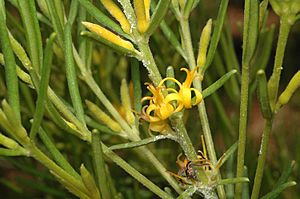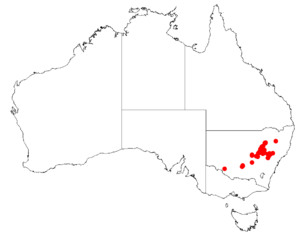Persoonia curvifolia facts for kids
Quick facts for kids Persoonia curvifolia |
|
|---|---|
 |
|
| In the Australian National Botanic Gardens | |
| Scientific classification | |
| Genus: |
Persoonia
|
| Species: |
curvifolia
|
 |
|
| Occurrence data from Australasian Virtual Herbarium | |
| Synonyms | |
|
|
Persoonia curvifolia is a special plant that belongs to the Proteaceae family. You can only find it growing naturally in central New South Wales, Australia. It's a type of shrub that can grow upright or spread out. It has long, thin leaves and pretty yellow flowers that are a bit hairy.
What Does It Look Like?
Persoonia curvifolia is a shrub that can grow straight up or spread out wide. Its bark is smooth. When the branches and leaves are young, they feel a bit hairy.
The leaves are long and thin, like a line. They can be from 10 to 50 millimeters (about 0.4 to 2 inches) long. They are also very narrow, only about 0.5 to 1.3 millimeters wide. The bottom side of the leaves has a small groove.
Its yellow flowers grow in groups. You might see up to eighteen flowers on a single stem, called a rachis. This stem can be from 5 to 50 millimeters long. Each flower sits on its own small, hairy stalk, called a pedicel, which is about 2 to 3 millimeters long.
The flower parts, called tepals, are yellow and measure about 10 to 13 millimeters long. They have some hair on the outside.
How It Got Its Name
The plant Persoonia curvifolia was first officially described in 1830. A famous botanist named Robert Brown wrote about it. He included it in his book called Supplementum primum Prodromi florae Novae Hollandiae. The plants he studied were found near Port Jackson by someone named "D. Cunningham."
Where Does It Grow?
This type of persoonia plant likes to grow in woodlands and forests. You can find it in New South Wales, Australia. It grows south from the Warrumbungles and Goulburn River areas. It also grows as far south as the Cocoparra National Park. These plants usually live at heights between 180 and 500 meters (about 590 to 1,640 feet) above sea level.

